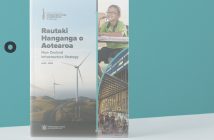Imagine a world where the health of the environment and wellbeing of citizens are paramount in economic, social and political decision-making. The infrastructure industry revolutionises, following the principles of the circular economy
- Geopolitical context (multilateral)—Comprehensive cooperation ensures geopolitical alignment on global public goods, such as climate change and income equity, and manages an ever-deepening system of economic, financial and social integration. The infrastructure industry is global, with private firms working in partnership with a strong state.
- Pace of climate change (managed)—Mitigating further climate impact outweighs other decision metrics. A combination of global cooperation and technological progress revolutionises the infrastructure industry with a focus on prioritising the ‘greenest’ technology possible.
- Technological progress (incremental)—Technological innovation is focused on enhancing the circular economy and lowering environmental impact of economic activity. The infrastructure industry sacrifices productivity gains for a lighter environmental footprint despite clear potential from less ‘green’ technology.
READ MORE: Infrastructure Futures scenario one – Conflicted Planet
READ MORE: Infrastructure Futures scenario two – Digital Planet
In The Green Planet scenario, environmental caretaking becomes the primary determinant of social and economic value, driving policy decisions for governments around the world. Safeguarding the world’s environmental and climatic systems is a powerful coordination mechanism that drives sustained global collective action. The impact of global cooperation is considerable, with significant advancements in the climate mitigation agenda as advanced technologies are deliberately commoditised to enable emerging world economies’ use. Additionally, consumers take up the challenge of reorienting the demand for goods to more sustainable products and production processes (such as the ‘sharing economy’) that reshapes global food production and processing.
Global trade has slowed as consumer demand shifts to domestically produced goods and services. Productivity gains run at a lower rate as public funding concentrates on the development of climate-smart technologies, processes and materials. Moreover, governments broaden sustainability principles to include wealth equity, which is achieved through stronger enforcement of taxation policies (of corporates and individuals) and clamping down on any form of BEPS.
In this scenario, the role of the state is paramount. Economic incentives are recast in many economies by more agile (and globally harmonised) taxation systems and the focus on improving economic, environmental and social equity. These three principles become the rallying point for a system of international cooperation and, in particular, for international organisations that, despite dampened economic prospects in many countries, pursue developmental programs around the world.
Global governance embraces the notion of creating an equal, sustainable and vibrant international community. Global governance architecture is critical as not all regions of the world are fully able to mitigate the impacts of a changing climate, especially across emerging markets. Adaptation strategies are needed to safeguard the livelihoods of people living in the most climate-affected regions, particularly the small states with constrained fiscal and technological resources. Global assistance is required to construct
resilient infrastructure, such as sea walls, and for programmatic support, such as long-term supplies of potable water. This support is viewed as a globally emblematic program for social equity between emerging and mature markets.
The Green Planet scenario evolves from stigmatising the infrastructure (and mobility) industry to championing its transition to environmental neutrality. Heavy public investment in the research and development of climate-responsive building materials, lowto no-emitting construction machinery, electrified transportation (linked to renewable generation sources), and iron-clad efficiency regulations have transformed the industry. Profit pools shift to the building materials sector, which continues to develop innovative building materials that are climate-smart, environmentally sustainable and legally mandated for use.

Circular economic policy fosters new business models
In this scenario, infrastructure business models are designed to adhere to the regulatory regimes underpinning the circular economy. The shift in social values and in government regulation promotes opportunities for service-oriented businesses, such as environmental planning for decommissioning and environmental impact auditing. Significant opportunities also emerge in sharing platforms (transport, housing, and equipment, for example) and in recycling building materials. Fiscal policy promotes the use of
locally-sourced recycled materials and serves as the basis for new, local enterprises created to recycle building materials.
Design and engineering firms provide experience and capabilities in up-front comprehensive analyses of an asset’s environmental impact over the course of its lifetime. Environmental auditing is now a legal requirement for every asset, not only in major mature markets but also in emerging economies, and assessing opportunities to reuse an asset at the end of its life cycle becomes a lucrative business.
Focus on sustainability
Demand for infrastructure changes through a combination of shifts in consumer preferences and regulations. Consumers live intensely local lifestyles with the lowest possible carbon footprint. They avoid private transportation, preferring shared and electric options, while regulations have outlawed any form of transportation or energy generation driven by fossil fuels. Network industries have, therefore, changed with mass reductions in the capacity within the inter-city road network and the power sector is dominated by green technology companies capable of both developing utility-scale renewable projects, as well as installing micro-grids (and off-grid solutions) for specific communities.
Cities use sophisticated technology to overcome intra-city congestion by deploying real-time traffic optimisation software and comprehensive infrastructure asset pricing models that charge consumers dynamically fotr use of transportation networks, be they public or private. Many cities have passed regulation banning vehicles from the urban core, encouraging citizens to use other mobility options from electrified bicycles to scooters and mopeds. Urban planners prioritise green spaces, often constructed on or
around decommissioned assets in order to revitalise previously unused portions of the city.
Shift to sustainable technologies
Energy demand continues to grow, as does the demand for recycling infrastructure. Renewable sources dominate energy generation, such as solar, wind, and wave energy, and investments in these assets rise. Extensive networks of ‘prosumers’ (consumers who are also involved in producing goods) generate their own energy and sell it back to the grid at scale; similarly, they recycle their water and sell the excess. This generates competition across infrastructure markets, which were previously dominated by natural monopoly providers and also creates scale for innovative technologies. Waste policy is shaped by the circular economy and compulsory waste separation is in force across the world. Infrastructure assets, such as wastewater treatment plants and waste-to-energy plants, are ubiquitous.
The Green Planet scenario sees the infrastructure development process evolve significantly around the principle of how to plan, design, build, operate and decommission assets in the cleanest, greenest and most socially responsible manner. InfraTech is deployed to limit negative environmental impact, rather than to boost productivity, which has become a secondary requirement. Productivity losses are exacerbated by labour policies enshrining a ‘right to work’.
At the asset planning and design stages, regulation requires developers to run complex simulations that estimate an asset’s potential environmental impact over its lifetime. These simulations take into account the construction impact of the asset, and the carbon-intensity of its operations and decommissioning. This estimate is audited by government against strict qualifying criteria before an environmental licence to build or operate is issued. Additionally, adaptive capacity for infrastructure assets must be incorporated at the design stage. Designs must be submitted for climate-robustness assessments to gauge longevity, and prioritise resilience and adaptability. Furthermore, developers are also legally required to conduct thorough stakeholder engagement activities to ensure that disadvantaged groups can have their say and that there is a more equal distribution of the benefits.
During the construction phase, technologies are employed onsite to reduce the environmental impact of the construction process. For example, AI-powered 3D printing creates building elements onsite to minimise transportation impacts and the chance of offsite contamination. Breakthroughs in material science focus on regenerative materials to increase an asset’s durability and reduce maintenance costs—for instance, asphalt that resets itself through induction heating, concrete mixed with living bacterial aggregates that can patch up cracks, and new alloys with self-healing properties.
Once operations commence, the regulatory role of the state is significant. Data and analytics from the real-time operations of the asset are fed to environmental enforcement agencies that ensure the asset’s environmental impact remains within acceptable limits. Sustainability agencies verify that each asset’s environmental impact during and after construction matches projections created by design-stage simulations. Penalties and reputational damage are severe, turning asset management into a highly specialised field.
Greenfield projects discouraged and brownfield projects heavily regulated
The Green Planet scenario is, in part, a product of the state’s strength to incentivise private investment and consumption into goods and services that are environmentally sustainable. Supported by broad-based global cooperation, governments implement policies that encourage asset optimisation and preservation over new builds. Existing assets are kept operating as long as possible, requiring significant retrofits and maintenance work to extend useful lives.
Governments provide ring-fenced funding and tax incentives to investors to encourage a focus on existing assets in what is termed ‘smart growth policy’. As part of this, land use policies focus on increasing densification to reduce carbon footprint. Governments assume the risk of obsolescence by subsidising investment to prolong the useful life of assets that face potential disruption from technological advances (for assets that still meet stringent environmental conditions).
Greenfield projects are rare, especially in mature economies. Proposals for greenfield projects must pass stringent environmental criteria as well as lengthy stakeholder engagement processes that, in part, must prove the asset’s contribution to the national strategy for climate mitigation or resilience. Global coordination enables emerging markets to invest in the new assets required to mature the domestic infrastructure stock to meet industrial and consumer demand.
This scenario has been taken from the Global Infrastructure Hub’s Infrastructure Futures report. The scenarios offer deliberately extreme, yet plausible, versions of the future. They are not predictions, but are instead designed to prompt debate and encourage members of the infrastructure community to investigate the potential impacts and implications of these scenarios, and take action to ensure their strategies and plans are resilient to the full range of possible developments.




